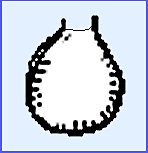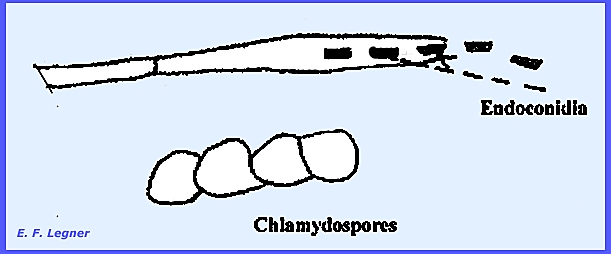File:
<deuteromycota.htm> <Index to Mycology> Pooled References <Glossary> Site
Description <Navigate to
Home>
Page 1
True Fungi (Eumycophyta) 1
Deuteromycota – Fungi
Imperfecti
(Contact) Please CLICK on underlined
links & included illustrations for details Use Ctrl/F to search
for Subject Matter:
Introduction This group of fungi comprises over
20,000 species and is very important in breaking down organic matter, as
plant and animal pathogens and for industrial importance. They are all higher true fungi, which lack
a known perfect stage. Their mycelium
is like that in the Ascomycota and vegetative reproduction structures are
common to both groups. Over 90
percent of the important fungi that have been shown to possess a perfect, or
sexual, stage have been Ascomycota.
Most of the Deuteromycota produce conidia of one kind or another. There is substantial evidence that at
least the majority of these fungi are of Ascomycetous affinities. Indeed, it is probable that a great many
of them are Ascomycota whose perfect stages have simply escaped
discovery. Mycologists continue to
report finding ascigerous stages of several fungi previously included in this
group. Thereafter these drop out of
the Fungi Imperfecti and are renamed and reclassified on the basis of the
newly acquired information. How many
other members of the Fungi Imperfecti will in a similar way ultimately be
eliminated from the group can only be conjectured. However, it seems likely that among the large number of species
at present catalogued as Deuteromycota, there are some that never do produce
a perfect stage, perhaps having lost the ability in the course of evolution,
reproduction by conidia or other vegetative means having proved adequate for
survival. Four orders that will be
discussed here are Sphaeropsidales, Melanconiales, Moniliales and Mycelia Sterilia. In 1952 Alexopoulos gave a
detailed narrative of the Deuteromycota, and the following description is
derived therefrom [Alexopoulos, C. J. 1952.
Introductory Mycology.
John Wiley & Sons, NY. 482
p.]. ------------------------------------- A great many
fungi are known which have septate mycelium and which, so far as anyone has
been able to discover, reproduce only by means of conidia. Since these fungi
apparently lack a sexual phase (perfect stage), we call them commonly
"imperfect fungi," and technically "Fungi Imperfecti."
Many of these are saprobic, but many are of great importance to us because
they are parasites that cause diseases of plants, animals, and human beings.
The same
methods employed for the formation of pycnidia also serve for the formation
of. acervuli, the origin of which may be simple meristogenous, compound
meristogenous, or symphogenous. This undoubtedly explains the fact that
intermediate forms, between pycnidia and acervuli are produced by some fungi
which ~re, therefore, difficult to classify.
------------------------------------- Sphaeropsidales In
this order the spores are borne in a flask-shaped pycnidium on the inside of
which are conidiophores bearing conidia (pycnospores). Four
form-families have been distinguished as follows: (1) Sphaeropsidaceae
(pycnidia dark colored,
leathery to carbonous, stromatic or non-stromatic generally provided with a
circular opening). (2) Zythiaceae (pycnidia
as in the Sphaeropsidaceae but light colored instead of dark, and soft or
waxy instead of leathery). (3) Leptostromataceae (pycnidia
shield-shaped or elongated, flattened).
(4) Excipulaceae (mature pycnidia
somewhat deeply cup-shaped). In the family Sphaeropsidaceae species of the genus Darluca are
hyperparasitic on rusts. Species of Cicinnobolus
are hyperparasites of powdery mildew.
Their mycelium is grown longitudinally in the mycelium of their hosts. ------------------------------------- Please
refer to the following plates for characteristic structures in the
Sphaeropsidales: Deuteromycota (Fungi
Imperfecti): Sphaeropsidales Plate
150 = Pycnidia types: Zythis fragariae, Dendrophoma
abscurans, Chaetomella atra, Diplodia zeae, Fusicoccum viticolum & Endothia parasitica. Plate 151 = Pycnidial
development: Phoma herbarum, P.
pirina & Zythia fragariae. Plate 153 = Sphaeropsidales: Pycnidiospore types. Plate
240 = Example Structures:
Deuteromycota: Sphaeropsidales: Sphaerioidaceae ------------------------------------- Melanconiales Spores are borne on an
acervulus in this order (as in the genus Higginsia of the Ascomycota) Only one
form-family has been designated: Melanconiaceae. Many species are parasitic on plants and
cause a group of diseases called anthracnoses. The acervuli that are the characteristic
structures of this family usually develop below the cuticle or below the
epidermis of the host plant. They
release their conidia in characteristic droplets, which may be white,
cream-colored, pink, orange or black depending on the pigmentation of the
conidia. In the family
Melanconiaceae the
genus Gloeosporium
has setae, the genus Colletotrichum does not have setae and Cylindrosporium
is lit the genus Higginsia of the Ascomycota: Helotiales. ------------------------------------- Please refer to the
following plates for characteristic structures in the Melanconiales: Deuteromycota (Fungi Imperfecti): Melanconiales Plate 152
= Acervuli: Gloeosporium sp.
& Colletotrichum lindemuthianum. Plate 154
= Melanconiales: Conidia types. Plate 241 = Example
Structures: Deuteromycota: Melanconiales & Mycelia Sterilia ------------------------------------- Moniliales This
order includes all the other spore-producing forms and contains the greatest
number of species. Many species are
of great importance and the group contains most of the fungal
pathogens of humans. It is also the group that has many of the
fungi that or of industrial importance.
Species of Penicillium and Aspergillus that are not
known to form cleistothecia are included.
The so-named "false yeasts" that are not known to produce
ascospores are grouped here. There
are a number of serious plant pathogens as well and some common contaminants
of the biological laboratory and many soil fungi what are saprobic and may
play a significant role in the soil economy.
Eight family are included here. The family Stilbaceae has
a coremium or synnema. The majority
of species are saprobic. The
form-genus Graphium
is economically important because several species are
responsible for blue stain of lumber
that reduces market value. The
imperfect stage of Ophiostoma ulmi (= Graphium ulmi) belongs here
also. The family Tuberculariaceae has
a sporodochium, which is a cushion-like mass of hyphae. The genera Tubercularia, Volutella
and Fusarium are well known.
In Tubercularia the sporodochium is usually shaped like a
mushroom, with a very short stalk and a smooth surface. In Volutella the sporodochium produces
setae that arise here and there over the entire fructification. Volutella fructi causes Dry Rot
of Apples. The form-genus Fusarium is the largest in this family and taxonomically one of the
most difficult of all fungal groups. Fusarium
produces long, crescent-shaped, multiseptate macroconidia usually borne on
sporodochia, and very small spherical, oval elongated or crescent shaped
microconidia on simple or branched single hyphae. Chlamydospores are also regularly produced by the mycelium, and
sclerotia are often formed. Parasitic
species are generally vascular parasites that cause wilts of plants by
plugging the conducting tissues and by toxin secretions. Among the most destructive species are Fusarium
solani on potato, Fusarium cubense on banana and Fusarium
lini on flax (Plate 159). The families Moniliaceae and Dermatiaceae have
spores scattered over the mycelium.
The Moniliaceae have hyaline spores whereas the Dermatiaceae have dark
pigmented spores. The genus Thielaviopsis
has endoconidia, but they may also produce macroconidia or chlamydospores in
chains. The
Moniliaceae is the larges of all the form-families. It includes all imperfect fungi that produce conidia on
unorganized, hyaline conidiophores or directly on the somatic hyphae. Most species are saprobic, but many are
important plant parasites
and others are human pathogens. The imperfect stages of Aspergillus and
Penicillium belong here (Plate 102,f). The family Dermophyta is
related to Gymnoascaceae of the Ascomycota. In the family Cryptococcaceae there
are asporagenous yeasts, which are related to Saccharomyces of the
Ascomycota. The Genus Candida incites a human disease
called "Thrush." The Genus Cryptococcus
includes animal pathogens and Torulopsis is
a food yeast that is used for animal food. The family Rhodotorulaceae is asporagenous yeasts
that are possibly related to the Basidiomycota: Dacryomycetales. The family Sporobolomycetaceae is
also asporagenous yeasts that are possibly related to the Basidiomycota: Dacryomycetales. Sporobolomyces species have pink or orange-pigmented
forms. They may reproduce by simple
budding or they may produce sterigmata with spores that are shot off forcibly
(= ballistospores). ------------------------------------- Please refer to the
following plates for characteristic structures in the Moniliales: Deuteromycota (Fungi Imperfecti): Moniliales Plate 155
= Capsules of Cryptococcus neoformans. Plate 156
= Structures of Candida albicans & Geotrichum sp. Plate 157
= Budding & spore production: Nectaromyces
spp. & Sporobolomyces spp. Plate 158
= Moniliales: Conidia types. Plate 159
= Sporodochium of Fusarium lini & Fusarium sp. Plate
242 = Example Structures:
Deuteromycota: Moniliales ------------------------------------- Mycelia Sterilia includes a group of fungi in which no
conidia or other reproductive cells are known. Sclerotia are formed, but there are no fruiting bodies (=
spores). Many of the Mycelia Sterilia
proved to be Basidiomycota when their perfect stages were discovered. Of the over two form-genera in this group,
Rhizoctonia
and Sclerotium are the best known and most
widely distributed. Rhizoctonia
is usually found in soils causing damping-off and
root rot of their host
plants. Pellicularia
filamentosa, a basidiomycete, has Rhizoctonia solani as
its imperfect stage. It causes Black
Scurf of potatoes
and attacks other plants as well. Sclerotium cepivorum known in the form of small black
slcerotia produced on white, cottony hyphae, causes white rot of onions and
garlic. Sclerotium rolfsii is
omnivorous and can be very destructive on plants. ------------------------------------- Please
refer to the following plates for characteristic structures in the Mycelia
Sterilia: Deuteromycota (Fungi Imperfecti): Mycelia
Sterilia Plate 241 = Example
Structures: Deuteromycota: Melanconiales & Mycelia Sterilia ------------------------------------- Recognition of Tribes And Sub-Tribes The final subdivision of most of
the families into the equivalent of tribes and sub-tribes is done on the basis
of spore form, structure and color, and utilizing the "Saccardo
Spore Sections" (= Italian mycologist: 1880-1925) with the
following possibilities: Amerosporae = spores 1-celled but not long, notstellate, spiral, or
filiform Hyalosporae = spores hyaline Phaeosporae = spores dark Didymosporae = spores 2-celled, not stellate, spiral, or filiform Hylodidymae = spores hyaline Phaeodidymae = spores dark Phragmosporae = spores more than 2-celled (variable), not stellate,
spiral, or filiform Hyalophragmiae = spores hyaline Phaeophragmiae = spores dark Scoloecosporae = spores long and slender (scolecospores) septate or
non-septate Dictyosporae = spores muriform Hyalodictyae = spores hyaline Phaeodictyae = spores dark Helicosporae = spores spirally coiled, continuous or septate Staurosporae = spores
stellate (star-shaped) or radiate, continuous or septate ======================== |


